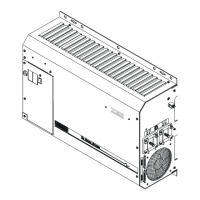CONTROLS, INDICATORS AND COMPONENTS
Copyright Trace Engineering Company, Inc.
5916 - 195th Street N.E.
Arlington, WA 98223
Telephone: 360/435-8826
Fax: 360/435-2229
www.traceengineering.com
PS Series Inverter/Charger
Part No. 3597
Rev. D: November 23, 1999
Page
11
RED = ERROR
ON: Indicates that there is no AC voltage available on the output. The red error LED is used in conjunction
with the yellow (invert) LED to determine the operating mode of the inverter. If the red LED is on and the
yellow (invert) LED is off, then the inverter is in standby (DC power connected but not turned on) and is
ready to turn on. With the red LED on and the yellow LED blinking twice a second with a one second pause,
then the inverter is in the CHG (charge only) mode and waiting for AC to be connected to the input. If the
red LED is on and the yellow (invert) LED is flashing rapidly (4 times/second), this indicates that an error
condition exists. Refer to the INVERT (yellow) LED for more information on error causes.
YELLOW = INVERT
OFF – INVERTER/CHARGER IS OFF: The inverter is off and not operational. This is the default position
of the inverter upon power-up. No AC output is available.
ON – INVERTER/CHARGER ON: The inverter is operational and AC output is available. Inverter is
providing AC power from the batteries or the input AC source is providing pass-thru power to the output.
ONE BLINK/SEC – SEARCH: The yellow LED will blink once each second to indicate the inverter is in
search mode and is looking for an AC load greater than the SEARCH WATTS setting (default = 16 watts).
DOUBLE BLINK/SEC – CHARGE ONLY MODE (CHG): The yellow LED will double blink then pause for
a second to indicate that the unit is in Charge Only mode.
RAPID BLINK (4/SEC) – ERROR MODE: The yellow LED will blink rapidly to indicate that an operating
error has occurred. This can be caused by over-load or over-current, over-temperature (transformer or
heatsink), high or low battery voltage, AC source wired to the output, or an external (stacked) error. When
the inverter senses one of these situations, it may protect itself by disconnecting from the loads. There
are also advisory and numerous generator-related errors that will not disconnect the AC loads. Refer to
each error cause below to help determine your particular error cause.
ERROR CAUSES (AC OUTPUT WILL BE DISCONNECTED):
If an over-current condition exists, the inverter will shutdown and must be reset with the power button. If
the error condition is based on over-temperature (transformer or heatsink), or high or low battery voltage
the error protection circuitry resets automatically.
Low Battery voltage: Your battery voltage is below the LOW BATTERY CUT OUT (LBCO) VDC setting
and the inverter has shut off to prevent over-discharge of the battery. Allow the battery to recharge or
connect to an AC source such as a back-up generator. The inverter will reset when the battery exceeds
the LBCO setting.
Low inverter voltage: Your inverter/charger monitors the minimum AC voltage level of the AC output.
This assures a continuous supply of quality Alternating Current to your electrical loads. The inverter AC
output voltage level is determined by the SET INPUT LOWER LIMIT VAC setting. If the AC voltage falls
below this setting continuously for 32 seconds the inverter disconnects from the loads and turns on the
error LED. The cause for this error could be high battery voltage or an excessively large load.
High Battery voltage: The inverter turns off due to a high battery voltage condition determined by the
HBCO (HIGH BATTERY CUT-OUT) setting. This can be caused by the solar array or other charging
source not being regulated. Check the controller for proper operation. Some controllers have a “equalize”
setting which over-rides the normal operation, allowing the battery voltage to be unregulated. Return the
controller to the “normal” setting and check for proper operation. If you are using NiCad type batteries,
you will need to increase the HBCO setting. The inverter will automatically reset once the battery voltage
has dropped 1.5 volts below the HBCO setting.
Over-temperature (Transformer or Heatsink) : The transformer or power transistors have exceeded
their safe operating temperature and the inverter has turned off. When operating as a battery charger, the
inverter will reduce its charging rate to prevent overheating. As an inverter, overheating can be caused by
attempting to operate too large of a load for too long, a failure of the inverter cooling fans, or that the air
flow into or out of the inverter is being blocked. The inverter will automatically reset once it has cooled.
While the inverter has shut down, AC power from any AC source may not continue to pass through the
inverter to power AC loads. Any power management provided by the inverter will not be able to occur
while the inverter is off.

